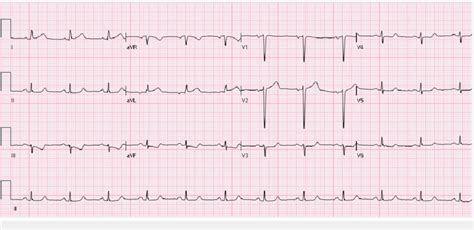nonspecific t wave abnormality|nonspecific st changes on ekg : Tuguegarao Learn the Heart - Healio provides a comprehensive tutorial on how to interpret ECGs and identify 68 causes of T wave and ST segment abnormalities. The tutorial covers the . Kung Fu Fighting Simulator CODES - ROBLOX 2023If you guys found this video helpful in any way please consider subscribing to the Codezzy youtube channel!Foll.

nonspecific t wave abnormality,Learn how to interpret non-specific T wave changes on ECG and how to differentiate them from cardiac causes. See a case of a 72-year-old male with chest pain and T wave inversion in the inferior .
nonspecific t wave abnormality Abnormal T wave inversion in leads V 4 –V 6 in a middle‐aged male. T wave inversion in leads other than V 1 –V 3 has been associated with a threefold risk of SCD . The most common ECG changes are nonspecific ST-segment and T-wave abnormalities, which may occur because of focal myocardial injury or ischemia caused by the metastatic tumor. In some .Learn the Heart - Healio provides a comprehensive tutorial on how to interpret ECGs and identify 68 causes of T wave and ST segment abnormalities. The tutorial covers the .
nonspecific st changes on ekgLearn what the T wave on an ECG represents, how it reflects ventricular repolarization, and what factors can affect its shape and duration. Find out how to . This activity reviews the definition of an electrocardiographic T wave, explains how different clinical states can cause changes to T wave morphology, and highlights the role of .Learn how to interpret the T-wave in ECG, which reflects the repolarization of the ventricles. Find out the causes and consequences of T-wave abnormalities, such as inversion, flattening, biphasic and .
In the absence of a clinical history or symptoms, T-wave abnormalities and flattened and depressed ST-segment changes are nonspecific. Some of the causes of .
Clinicians seek out major ST/T changes as key indicators of myocardial infarction/ischemia. However, subtle T wave abnormalities which are less than 2 mm in .This can be well documented in the use of the term nonspecific T-wave abnormality. This term is not used to indicate that the observed change of repolarization patterns is .This can be well documented in the use of the term nonspecific T-wave abnormality. . Both evidence-based classification and quantification of various patterns of nonspecific T-wave changes are currently missing, although some attempts have been made to link different T-wave shape abnormalities to individual repolarization channelopathies. .

Wellens Syndrome. Wellens syndrome is a pattern of inverted or biphasic T waves in V2-3 (in patients presenting with/following ischaemic sounding chest pain) that is highly specific for critical . Negative T waves at electrocardiogram in young healthy people are often a challenging finding for the clinical cardiologist, who should consider a normal variant of the electrocardiogram in youth, an athlete’s heart adaptation to physical activity, or an initial stage of a pathologic process such as right ventricular arrhythmogenic or hypertrophic .

Background and Purpose— In previous studies, isolated nonspecific ST-segment and T-wave abnormalities (NSSTTAs), a common finding on ECGs, were associated with greater risk for incident coronary artery disease. Their association with incident stroke remains unclear. Methods— The REGARDS (Reasons for Geographic . What Does Nonspecific T Wave Abnormality Mean On ECG? Tagged: Abnormality. Nonspecific ST-T wave changes are very common and may be seen in any lead of the electrocardiogram. The changes may be seen in all or most of the leads (diffuse changes), or they may be present contiguous leads, such as the inferior, lateral, or .nonspecific t wave abnormality nonspecific st changes on ekg BackgroundT‐wave abnormalities are common during the acute phase of non‐ST‐segment elevation acute coronary syndromes, but mechanisms underlying their occurrence are unclear. We hypothesized that T‐wave abnormalities in the presentation of non‐ST‐segment elevation acute coronary syndromes correspond to the presence of . Minor ECG abnormalities, especially minor nonspecific ST-segment and T-wave abnormalities (NSSTTAs), are common in asymptomatic individuals and often occur in the absence of other ECG abnormalities. 1–4 Isolated minor NSSTTAs generally represent very minor or upsloping ST-segment depression and flat or minimally inverted .
Abnormal EKG results don’t always signal a major heart health problem. Although a person can have a variation in the normal rhythm without it affecting their overall health, unusual EKG results .
nonspecific t wave abnormality|nonspecific st changes on ekg
PH0 · t wave inversion on ekg
PH1 · st&t wave abnormality reason for concern
PH2 · nonspecific t wave abnormality means
PH3 · nonspecific t wave abnormalities ekg
PH4 · nonspecific t abnormalities lateral leads
PH5 · nonspecific t abnormalities anterior leads
PH6 · nonspecific st changes on ekg
PH7 · non specific t wave abnormality mayo clinic
PH8 · Iba pa